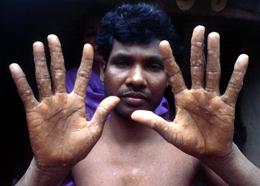Tubewells in seven wards of Chittagong City Corporation are pumping water with arsenic contamination 10 times higher than the safe level.
The wards’ low-income group people are especially exposed to arsenic related diseases as they drink and use water from those tubewells to meet daily necessities.
CCC and other authorities have so far taken no initiative to protect the endangered population, alleged local residents.
CCC and Public Health Engineering Department (PHED) are rather pointing fingers at each other, saying it is the other’s duty to detect and seal the contaminated tubewells.
Users of those tubewells do not even know that they are being exposed to high levels of arsenic.
The findings were revealed by a recent survey jointly conducted by the Chittagong University of Engineering and Technology (Cuet), and the Institute of Engineers of Bangladesh, Chittagong.
The seven affected wards are East Sholoshahar, South Kattali, West Bakalia, East Bakalia, South Bakalia, North Agrabad, and North Halishahar.
According to World Health Organisation (WHO), 0.05 ppm (part per million) arsenic in water is safe for human body.
But tubewells in North Halishahar and East Sholoshahar are pumping water that contains 0.5 ppm arsenic, 10 times higher than the safe level.
Dr Swapan Kumar Palit of the civil engineering department at Cuet said the seven wards have been identified as more risky. His department has done a detailed survey in East Sholoshahar recently.
Of the 233 tubewells in ward 6 of East Sholoshahar, 99 pump water with high levels of arsenic, said Dr Swapan, who is the key researcher in the survey.
Areas affected by the highest level of arsenic in the ward are Baraypara, Ghasia Para, Chairman Ghata, and Omar Ali Matabbar Road, Swapan said adding that generally low-income group people and slum dwellers live in these areas with no water supply from the Water and Sewerage Authority (WASA).
Dr Swapan said the survey was launched in 2008.
He said CCC and PHED should seal the contaminated tubewells, so no one could be affected.
Both the authorities, however, are trying to shift the responsibility on the other.
“We have no role in sealing tubewells in the city area,” a PHED official said, asking not to be named.
CCC officials, on the other hand, said the civil surgeon and PHED are the authority in this regard.
Civil Surgeon Dr Mohammad Abu Taiyab told The Daily Star, “The city corporation has more of a responsibility to seal the tubewells.”
He however added, “If they report to us, we will also take action.”


